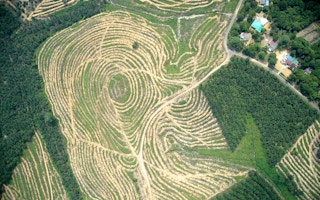He’s back. Tan Sri Dr Mahathir Mohammed reclaimed the position he had held for more than two decades as prime minister of Malaysia after a bitterly contested election last week. His party, Pakatan Harapan, brought an end to the rule of incumbent Najib Razak, whose government had been beset by allegations of corruption and misrule.
To continue reading, subscribe to Eco‑Business.
There's something for everyone. We offer a range of subscription plans.
- Access our stories and receive our Insights Weekly newsletter with the free EB Member plan.
- Unlock unlimited access to our content and archive with EB Circle.
- Publish your content with EB Premium.
Corruption was an issue that troubled Mahathir’s administation during his 22 years in charge. But what about sustainability? Will his re-emergence mean a greener Malaysia, or the opposite?
Mahathir’s sustainability record might not provide environmentalists with much reason for cheer. Under his leadership, from 1981-2003, about 5 million hectares of forest cover was lost, or about 69 times the size of Singapore.
A written correspondence between a 10-year old British boy and Mahathir in 1987 illuminates Mahathir’s pragmatic stance on deforestation. In response to the boy’s claim that deforestation in Malaysia as a result of the timber trade was “disgraceful,” Mahathir’s reply concerned the economic, health, and educational benefits of logging. He also pointed out that during the time of British rule, millions of hectares of forest was burned to make way for rubber plantations.
“
The timber industry helps hundreds of thousands of poor people in Malaysia. Are they supposed to remain poor because you want to study tropical animals?
Mahathir’s response to a British boy who appealed to the former PM to curb Malaysia’s timber industry.
Mahathir’s letter mentioned Malaysia’s abundance of national parks, “where nobody is allowed to fell trees or kills animals. In any case we don’t cut all the trees when we do logging in the forests. Only marked mature trees are cut. We also do reforestation.”
But since the time of that letter, Malaysia failed to fulfil environmental protection regulations. Timber companies in Sarawak were not affected by crackdowns on illegal logging, and continued to decimate protected forested areas, razing vast swathes of Malaysia’s biodiverse eco systems. The previous ruling party took action only when the choking haze drifted across to Peninsula Malaysia. But it was too little, too late.
Mahathir’s appetite for renewable energy is another worry. Malaysia maybe Southeast Asia’s third largest solar market, but that is hardly a claim to fame. The number of solar panel installations in Malaysia has actually declined in recent years, it was recently pointed out by Assaad Razzouk, chief executive of clean energy firm Sindicatum Sustainable Resources. This is due in part to the end of a feed-in tariff that allowed solar panel owners to sell their energy back to the grid.
What the doctor ordered?
Policies to protect the environment might be borne out of Mahathir’s medical background. Air pollution could be reduced through traffic control and investment in public transport. But then again, it was Mahathir who oversaw the launch of Proton, Malaysia’s first local automobile manufacturer to make cars more affordable at subsidised petrol prices. Cleaner air in Malaysian cities might not be on the horizon.
Under the previous ruling party, Najib made a clear pledge to reduce carbon emissions by 45 per cent of 2005 levels by 2030 after the Paris climate deal was struck in 2015. Will Mahathir stick to this promise? Much of Najib’s commitment was predicated on keeping carbon ‘locked’ up in the country’s 20.3 million hectares of rainforests, which absorb about 31 per cent of the CO2 the country produces, according deputy natural resources and environment minister Datuk Seri Dr James Dawos Mamit. “The targeted 40 per cent reduction in carbon emission intensity is something we can achieve or probably have achieved already with the help of our forests,” he said.
According to the Malaysian Palm Oil Council (MPOC), Malaysia’s massive palm oil industry can help with that. Oil palm trees, which cover 5 million hectares of plantation area, are the country’s second largest carbon sink, according to MPOC. Though environmentalists may frown upon the emissions it produces and the land it needs to grow, the biofuel palm oil produces is a major source of renewable energy.
Much depends on whether Mahathir will respect the pledges set by his predecessor to prioritise reforestation and sustainability to tackle climate change.
The Tun-minator
Mahathir’s election may bode well for enforcement. The departments charged with environmental protection will have to buck up and do their jobs, carrying out and regulating the environmental protection policies in place.
The hope is that Mahathir and his new cabinet will shed government inertia and carry out their duties to protect the country’s natural resources. One reason for optimism is Jomo Kwame Sundaram, an economist known for his environmental inclinations, who wrote the book Deforesting Malaysia: The political economy and social ecology of agricultural expansion and commercial logging. Sundaram is part of an advisory team Mahathir has appointed before he chooses his new cabinet.
The reality is, however, that for the majority of Malaysians who voted Pakatan in, green issues were not at the top of their agenda. Curbing rising living costs and stamping out institutional corruption were the underlying motives. Who then is responsible for prioritising sustainability? Although democracy triumphed, sustainability may fall lower down the political agenda.
Additional reporting by Alaine Johnson and Robin Hicks









